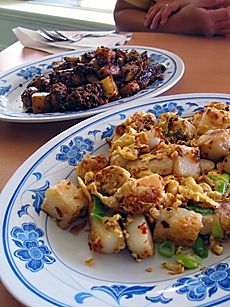Chai tow kway facts for kids
 |
|
| Alternative names | Fried carrot cake, carrot cake |
|---|---|
| Course | Yum cha |
| Place of origin | Chaoshan area, Guangdong, Southern China |
| Region or state | Chaoshan (China), Indonesia, Singapore and Malaysia |
| Main ingredients | steamed rice flour, water, and shredded white daikon |
| Variations | Turnip cake |
| Chai tow kway | |||||||||||||
|---|---|---|---|---|---|---|---|---|---|---|---|---|---|
| Chinese name | |||||||||||||
| Traditional Chinese | 菜頭粿 | ||||||||||||
| Simplified Chinese | 菜头粿 | ||||||||||||
| Hokkien POJ | chhài-thâu-koé, chhài-thâu-ké | ||||||||||||
|
|||||||||||||
| Thai name | |||||||||||||
| Thai | ขนมผักกาด [kʰā.nǒm pʰàk kàːt] | ||||||||||||
| RTGS | khanom phak kat | ||||||||||||
Chai tow kway (which means radish cake in the Teochew language) is a popular dish from Teochew cuisine. It comes from the Chaoshan area in China. You can also find it in countries like Indonesia, Singapore, Malaysia, Thailand, Taiwan, and Vietnam. This tasty dish is made by stir-frying small cubes of radish cake.
What It's Called
In Southeast Asian countries, Chai tow kway is often called "fried carrot cake" or just "carrot cake." This can be a bit confusing! The main reason for this name is that the word for daikon (a type of white radish) in the local language sounds similar to the word for carrot. So, people started calling it "carrot cake."
It's important to know that this dish has nothing to do with the sweet Western carrot cake that you might eat for dessert. Chai tow kway is a savory (not sweet) dish. The name "carrot cake" is a bit of a misnomer, meaning it's a wrong or misleading name.
What's Inside
Chai tow kway is made from a special kind of cake called radish cake. This cake is prepared by steaming rice flour, water, and shredded white daikon (radish).
After the radish cake is made, it's cut into pieces and stir-fried. Other ingredients are added during frying, such as eggs, preserved radish, and different seasonings. Sometimes, the radish cake is steamed in large blocks and then fried whole.
Instead of radish, some versions of this dish are made with taro or just rice flour.
You can also eat the radish cake on its own. It can be simply steamed, or steamed and then pan-fried. These simpler versions are often topped with spring onions before serving.
Different Ways to Make It
The way Chai tow kway is made can be a little different depending on where you are.
In places like Johor and Singapore, where many Teochew people live, hawkers (street food sellers) usually fry the daikon cake with chopped preserved turnip, diced garlic, eggs, and Chinese fish sauce instead of soy sauce. Freshly chopped spring onion is added right before it's served.
If you go further north, for example to Kuala Lumpur, the dish looks darker. This is because they use dark soy sauce. They also often add bean sprouts.
In Singapore, there are two main types of Chai tow kway:
- The "white" version: This one doesn't use sweet soy sauce. The carrot cake is fried on top of a beaten egg, which forms a crispy crust.
- The "black" version: This version uses a sweet, dark sauce (like molasses). The egg is simply mixed in with the carrot cake pieces.
Why It's Important
Chai tow kway is very popular, especially in Singapore and Malaysia. People from all different backgrounds and cultures enjoy it, not just the Teochew community. You can find it in many places, from simple street food stalls to fancy Chinese restaurants.
It's a much-loved local "comfort food" in the region. This means it's a dish that makes people feel good and reminds them of home. People eat it at different times of the day. It can be a breakfast dish, a main meal for lunch, or even a late-night snack. Many well-known people in Singapore have also shared how much they love this dish.
See also
 In Spanish: Chai tow kway para niños
In Spanish: Chai tow kway para niños

